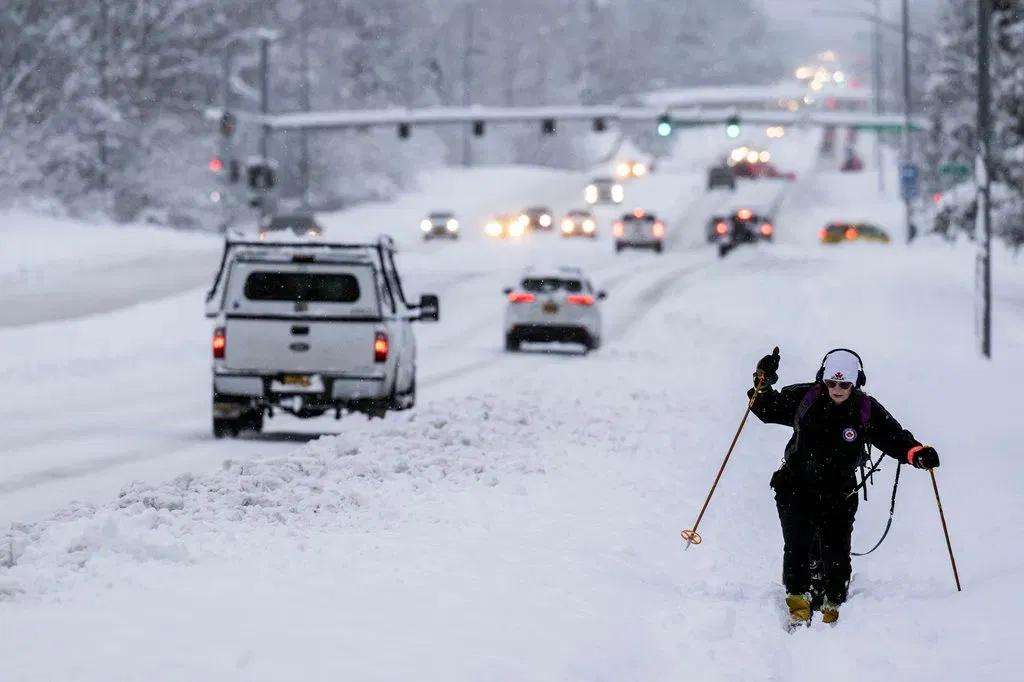Four homeless persons have died in Anchorage in the last week, highlighting the city’s difficulty to accommodate a large homeless population as winter weather returns with more than 2 feet (61 cm) of snow in 48 hours.

During a heavy snowfall on Thursday, November 9, 2023, in Anchorage, Alaska, a pedestrian carried a shopping cart along Cordova Street. (Source: US News)
Winter Weather Causes the Death of Migrants
The four raise the total number of people who died while living outside in Anchorage to 49 this year, surpassing the 24 who died on the streets of the state’s largest city last year, according to the Anchorage Daily News. Eleven deaths occurred in winter weather last year. This week’s heavy snow buried homeless people’s tents and vehicles in temporary camps across Anchorage after the city closed the pandemic-era mega-shelter at the sports arena. Some folks are roughing it outside this winter weather after the city cleared at least one huge camp. The fourth recent death occurred Thursday when a sleeping woman’s temporary shelter caught fire, probably due to a heating source.
Three more men died. One was found dead in a downtown gift store doorway where he typically slept. Another died on a major road near Walmart, and the third in a tent at an encampment near the city’s main library. Because shelter beds were available when each individual died, additional reasons such as a lack of transportation or health care, uncertainty about how to get a shelter bed or onto a waitlist, or refusal to go to a shelter may have been at play, according to the Anchorage Coalition to End Homelessness. To prevent outdoor mortality, access to health care providers, Narcan, fentanyl test strips, harm reduction counseling, and behavioral health treatment are all helpful approaches. Felix Rivera, chair of the Anchorage Assembly Housing and Homeless Committee, said of the four deaths, it make them wonder what they could have done better to prevent that circumstance from happening.
The city has increased temporary shelter beds, but he said more accommodation is needed to prevent more deaths. He stated, “We’ll do what we need to do to make sure folks aren’t dying outside, but if we’re not focusing on the permanent solution, then a Band-Aid will be worse.” “We’re going to run out of funds to keep doing this.” Anchorage has struggled to accommodate the homeless since the arena shuttered. The conservative mayor and liberal assembly couldn’t agree on a new mass shelter, so Mayor Dave Bronson suggested giving the homeless one-way plane tickets to leave the city, which was severely criticized in and out of Alaska. That plan was never funded, forcing the city to shelter in dilapidated hotels and apartments. Anchorage’s old garbage transfer station administration building became a 150-bed mass shelter late last month. The city’s homeless director, Alexis Johnson, told The Associated Press that the patchwork approach should provide enough beds for 3,100 vulnerable people.
READ ALSO: Swelling Number of Migrants During Winter Weather Struggles
Proposal of Warming Facilities
Rivera said one facility had 28 beds open Friday but would likely be filled by the weekend. The Bronson administration will propose adding 50 beds to the facility during an Assembly meeting next week, which Rivera welcomed. He expects the administration to propose warming facilities and extra shelters if needed. Rivera said the heavy snow prevented city buses from running Thursday and Friday, denying the homeless a warming spot. It also prohibited low-income persons from reaching shelters and other social services. During this week’s storm, the temperatures have been about 30 degrees F (-1 degrees C), but they will drop soon. Forecasts predict single-digit temperatures next weekend. The city’s official recording station, the National Weather Service office near the airport and shoreline, received 17.2 inches (43 centimeters) of snow this week. Other Anchorage neighborhoods, notably those near the Chugach Mountains on the other side, recorded up to 30 inches.
Snowfall broke two daily records. According to National Weather Service meteorologist Nicole Sprinkles, the 9 inches (22.86 centimeters) on Wednesday surpassed the 1982 record of 7.3 inches (18.54 centimeters) and the 8.2 inches (20.83 centimeters) on Thursday broke the 1956 record of 7.1 inches (18.03 centimeters). A ski resort in Girdwood, 35 miles (56 kilometers) south of Anchorage, reached 3 feet (0.91 meters). Anchorage’s total followed Sunday’s 6 inches (15 centimeters). The storm knocked out electricity, forcing schools to cancel or move to remote learning, and closed roads. Associated Press copyright 2023. We reserve all rights. This content cannot be published, broadcast, rewritten, or distributed.
READ ALSO: Warmer Weather is Expected in the Next 15-day of November

















































